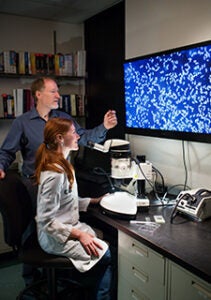Project objectives
 This research program consisted of several overarching objectives:
This research program consisted of several overarching objectives:
1) Laboratory experiments to understand the relative importance of light-harvesting and consumptive nutritional styles for mixotrophs under differing environmental conditions.
2) Development and application of novel tools and approaches to assess the nutritional strategies and requirements of mixotrophic microorganisms using gene expression information.
3) Characterization of the metabolic response shifts occurring in mixotrophic species with changing environmental conditions
4) Performance of field studies during natural blooms of the mixotrophic species studied in the laboratory to determine the nutritional modes being carried out under natural environmental conditions.
Laboratory culture studies
 Using controlled laboratory studies we are evaluated mixotrophic growth and gene expression behaviors. We employed high throughput transcriptomic studies with mixotrophic populations to provide snapshots’ of genes expressed under different environmental conditions of light, inorganic nutrients and prey availability. These approaches provide information on which genes in each organisms were associated and expressed highly or exclusively with each trophic process.
Using controlled laboratory studies we are evaluated mixotrophic growth and gene expression behaviors. We employed high throughput transcriptomic studies with mixotrophic populations to provide snapshots’ of genes expressed under different environmental conditions of light, inorganic nutrients and prey availability. These approaches provide information on which genes in each organisms were associated and expressed highly or exclusively with each trophic process.
 Culture-based studies of gene expression in our model mixotrophs were the cornerstone of our project. We have subjected these species to varying environmental conditions (the presence/absence of prey and light; inorganic nutrient replete and nutrient limited growth) and assessed the physiological response of the species through changes in their patterns of gene expression. These studies identified metabolic pathways that were up or downregulated in response to environmental conditions, and thereby the contributions of photosynthetic and heterotrophic growth to overall nutrition of the mixotrophs.
Culture-based studies of gene expression in our model mixotrophs were the cornerstone of our project. We have subjected these species to varying environmental conditions (the presence/absence of prey and light; inorganic nutrient replete and nutrient limited growth) and assessed the physiological response of the species through changes in their patterns of gene expression. These studies identified metabolic pathways that were up or downregulated in response to environmental conditions, and thereby the contributions of photosynthetic and heterotrophic growth to overall nutrition of the mixotrophs.
We also used recent advances in whole-transcriptome amplification to sequence minute amounts of RNA present in single Prymnesium cells from a population to evaluate the extent and nature of genomic and transcriptomic heterogeneity which occurs within populations. Single-cell approaches help us understand the scale and variability of transcriptomic diversity that occurs during the lifetime of an individual organism, and aid in the interpretation of field data.
Evaluating carbon and nutrient budgets of mixotrophic algae
In collaboration with Victoria Orphan’s lab at Cal Tech we utilized nanoscale high resolution secondary ion mass spectrometry (NanoSIMS) to quantitatively show ecological uptake of nutrients by protists.
Using nanoSIMS technology, postdocs R. Terrardo (USC) and A. Pasulkas (CalTech) evaluatedthe sources and fates of specific nutrient elements in cultures of the chrysophyte Ochromonas. This study quantified the carbon and nutrient nitrogen acquired from heterotrophic sources (i.e. eating prey) vs. inorganic sources (through photosynthesis and inorganic nutrient uptake) when grown with prey and in the light. The results indicated that this predominantly heterotrophic species acquired most of its cellular carbon and nitrogen from bacterial prey, when they were present. Carbon and nitrogen were derived from inorganic sources when prey were no longer available, but rates of growth were substantially curtailed on photosynthetic nutrition relative to heterotrophic nutrition. Pairing this information with gene expression data provided information on whether photosynthesis was down regulated when prey were available, or if photosynthetic efficiency was altered when prey were present (Terrardo et al, 2017).

NanoSIMS studies were also conducted with the predatory haptophyte Prymnesium parvum feeding on the ciliate Uronema marina. The results demonstrated a very different mix of photosynthetic and heterotrophic nutrition than observed for Ochromonas. P. parvum readily took up carbon and nutrients from the dissolved inorganics pools in the culture medium, and was capable of growth in the absence of prey. Nonetheless, P. parvum attacked and killed ciliates when they were present, and obtained nitrogen, but not carbon, from its prey. Inorganic carbon incorporated into the haptophyte’s biomass was still derived predominantly from inorganic sources even when prey were present.
II. Field-based studies:
 Field studies of algal mixotrophy in this project focused on metatranscriptomic analyses, 18S rRNA surveys, micro- and nanoplankton microscopy counts, and flow cytometry of natural microbial assemblages at three sites off the coast of Southern California that differ in nutrient input and human impact.
Field studies of algal mixotrophy in this project focused on metatranscriptomic analyses, 18S rRNA surveys, micro- and nanoplankton microscopy counts, and flow cytometry of natural microbial assemblages at three sites off the coast of Southern California that differ in nutrient input and human impact.
There has been great speculation regarding the nutrition of mixotrophs in nature. Yet it has been difficult to determine the specific trophic processes mixotrophs are using to obtain carbon, nutrients and energy in the field due to the challenges of separating mixotrophs from organisms that solely use phototrophy or phagotrophy. Our studies have provided new insight into the ecological strategies and evolutionary significance of mixed nutrition in small protists.
For more information, please see:
Publications related to this project